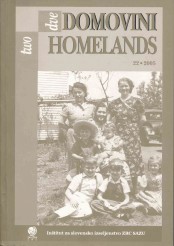IMMIGRANT CHILDREN IN AUSTRIAN SCHOOLS
Keywords:
integration, immigrant cultural differences, language problems, teacher education, immigration wave, intercultural approachAbstract
Approximately 45 % of all non-Austrian residents in Austria are nationals of the former Yugoslavia and 17.5 % are of Turkish origin. This is largely due to Austria’s geographical location, its earlier policy of recruiting workers from abroad and the admission, in the early 1990s, of refugees from the former Yugoslavia.. The Austrian constitution stipulates that state schools have to be accessible to all pupils, regardless of their origin, sex, race, class, language or religious belief. School attendance is compulsory for nine years for all children who have their permanent residence in Austria, regardless of their nationality. The total number of pupils attending compulsory schools in 2002/03 whose mother tongue is a language other than German was 103 877 (15.2 % of all pupils).
Austrian education policy rejects the idea of segregation. Hence, pupils who are not Austrian nationals and who have a mother tongue other than German are not taught in separate schools or classes but are educated alongside their Austrian colleagues. By law, immigrant pupils shall be integrated and at the same time their cultural identity be conserved and promoted which often creates problems with the daily school routine. For this purpose, intercultural education was introduced as a so-called ‘educational principle’ in Austrian compulsory and academic secondary schools in the early 1990s. Intercultural education aims at a mutual understanding between pupils of various social, cultural and linguistic backgrounds. It also aims to make them aware of their similarities and differences and to reduce Eurocentrism and racism in Austrian schools.
Nevertheless, reality shows that there are still a lot of problems to solve. Foreign pupils have worse chances than their Austrian colleagues in the educational system, there is a lack of intercultural friendships among pupils which often leads to an outcast-situation for immigrant pupils, and also conflicts between expectations of immigrant families and the Western culture can be observed. This again leads to an alienation from families and/or integration and identity problems of immigrant pupils.
Hence, a number of measures in the field of educational policy has to be implemented. Thereby an intercultural approach, as a chance of mutual learning from all different cultures, is to be preferred.
Downloads
References
Auemheimer, Georg (1995): Einführung in die interkulturelle Erziehung. Darmstadt: Wissenschaftliche Buchgesellschaft.
bmbwk (2003): Inform ationsblätter des Referats für interkulturelles Lem en, 2/2003. Wien.
Beer-Kem, Dagmar (1992): Lem- und Integrationsprozess ausländischer Jugendlicher in der Berufsausbildung. BerlinlBonn: Bundesinstitut fUr Berufsbildung.
Bommes, M ichael/Radtke, Frank-Olaf(1993): Institutionalisierte Diskrim inierungvon M igrantenkindem . In: Zeitschrift für Pädagogik, 3/93, 483-497.
Coleman, Joseph (1986): Equality of Educational Opportunity. W ashington: U. S. Government Printing Office.
Esser, Hartmut (1990): Interethische Freundschaften In: Esser, H artm utl Friederichs, Jiirgen (Eds.): Generation und Identität. Opladen: Leske und Budrich, 185-206.
Eurydice (2004): Integrating im m igrant children into schools in Europe - Austria 2003/04. Eurydice. (http://www.eurydice.org).
Friehs, Barbara (2004): EinfUhrung in die Theorie der Schule. Graz: Leykam.
G rießhaber, W ilhelm /Ö zel, B ilge/R ehbein, Jochen (1996): A spekte von A rbeitsund Denksprache türkischer Schiiler. ln: Ulonska, Herberti Kraschinski, Sven/ Bartmann, Theodor (Ed.): Lem forschung in der Grundschule. Bad Heilbrunn: Klinkhardt 160-179.
Haider et. al (2005): Zukunft: Schule. Strategien und M aßnahmen zur Qualitätsentwicklung. Wien: BM fUr Bildung, W issenschaft und Kultur.
Herrmann, Helga (1993): Ausländische Jugendliche in Schule, Ausbildung und Beruf. Köln: Böhlau.
Lentz, Astrid (1994): Institutionelle G renzen interkultureller Bildung und Erziehung. In: Informationsdienst zurAusländerarbeit: Interkulturelle Bildung und Erziehung, 2/94, 40-43.
Luchtenberg, Sigrid (1991): Zu Zweisprachigkeit und Bikulturalität ausländischer Kinder. In: Lajios, Konstantin (Ed.): Die Zweite und dritte Ausländergeneration. Ihre Situation und Zukunft in der Bundesrepublik Deutschland. Opladen: Leske und Budrich, 55-90.
Luchtenberg, Sigrid/Nieke, W olfgang (Eds.) (1994): Interkulturelle Pädagogik und Europäische Dimension. Herausforderungen fUr Bildungssystem und Erziehungswissenschaft. Münster: W axmann, 181-187.
Müller, Jürgen G. (1994): ...und raus bist du. Soziale Kompetenzen türkischer und deutscher Kinder in der Hauptschule. Frankfurt am Main: Lang.
Poschner, Hans (1996): Die Effekte der M igration au f die soziale Sicherung. Weiden/ Regensburg: Eurotrans.
Rademachers, Giinther (1996): Konflikte und Konfliktbewältigung in intra- und interkulturellen Freundschaften. Frankfurt am Main: Campus.
Radtke, Frank 0laf(1995): InterkulturelIe Erziehung. Über die Gefahren eines pädagogisch halbierten Anti-Rassismus. In: Zeitschrift fiir Pädagogik, 6/95, 853-864.
Rösler, Dietm ar (1994): Deutsch als Fremdsprache. Stuttgart/Weimar: Metzler.
Statistik Österreich (2001). Wien.
Statistik Österreich (2004). Wien.
Trenz, Günter (1994): Interaktionsprozesse im Unterricht. In: Bovet, Gislinde/Huwendiek, Volker (Ed.) Leitfaden Schulpraxis. Berlin: Cornelsen, 197-220.
Wenning, Norbert (1996): Die nationale Schule. Öffentliche Erziehung im Nationalstaat. M ünster/New York: Waxmann.
Downloads
Published
How to Cite
Issue
Section
License

This work is licensed under a Creative Commons Attribution-NonCommercial-NoDerivatives 4.0 International License.
Authors guarantee that the work is their own original creation and does not infringe any statutory or common-law copyright or any proprietary right of any third party. In case of claims by third parties, authors commit their self to defend the interests of the publisher, and shall cover any potential costs.
More in: Submission chapter





